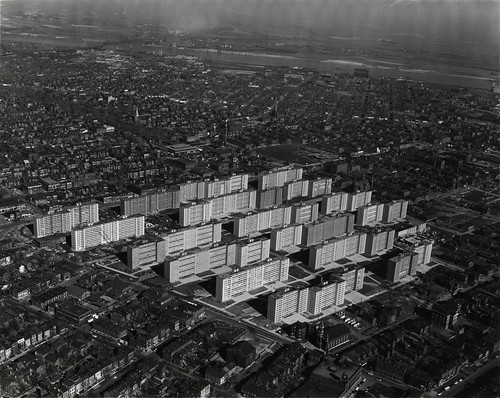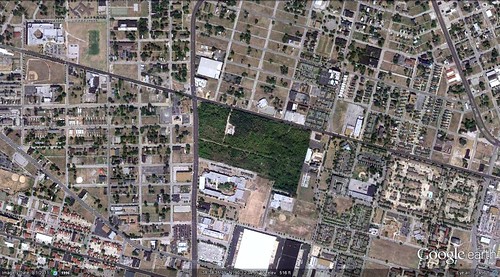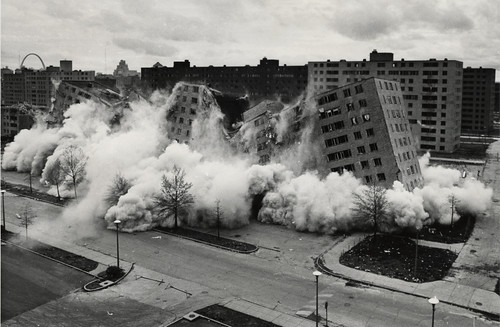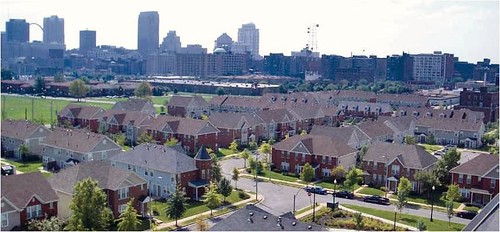Pruitt-Igoe and lessons from the failure of postwar housing policy

Posted March 2, 2012 at 1:30PM
Like the equally infamous Cabrini-Green public housing project in Chicago, the Pruitt-Igoe towers in St. Louis were once seen as beacons of hope, a way to bring quality housing to families in need, amidst green space and close to jobs and amenities. Built in 1954, the 33 nearly identical high-rises once stood where the large, green plot of land in the satellite image above is now. (Contrast the abandoned lots just to the north of the site with the densely packed housing in the older photo.)
What we know now but didn’t then, unfortunately, is that concentrating low-income, largely African-American families in an artificially contrived environment that isolated them from the rest of their communities - frequently with the approval of a fearful white elite who preferred it that way - was a formula for disaster. Whites fled America’s central cities beginning in the 1960s, taking their tax base and investment dollars with them, leaving behind what amounted to high-rise ghettoes plagued by poverty and devoid of hope and opportunity.
Those that could get out, did, leaving behind vacancies even in the housing projects that became breeding grounds for addiction and crime. Only now are we starting to emerge from some of the darkest decades of our urban history, with challenges remaining but lessons learned. Recognized as a failure, Pruitt-Igoe was famously demolished in 1972 (as was Cabrini-Green over time, beginning in 1995).
A recent publication by the federal Department of Housing and Urban Development summarizes some of the research findings relevant to concentrated poverty:
“Neighborhoods of concentrated poverty isolate their residents from the resources and networks they need to reach their potential and deprive the larger community of the neighborhood’s human capital . . . many neighborhood-level indicators are linked to important outcomes for people residing in neighborhoods of concentrated poverty, including crime and delinquency, education, psychological distress, and various health problems.”
Things are finally beginning to look up. Today, central cities are starting to rebound, faster in some places than others, of course. About a mile northeast of what was once Pruitt-Igoe, the once-abandoned historic neighborhood of Old North Saint Louis is becoming a model of revitalization done thoughtfully and well; to the southeast, the Murphy Park neighborhood (see photo) stands as a much more walkable and human-scaled approach to urban housing, a prototype of what we now know as the HOPE VI program (more recently expanded into Choice Neighborhoods). HOPE VI and Choice replace distressed, ghetto-style public housing projects with mixed-income communities more integrated into their cities.
From the same HUD publication:
“HOPE VI and Choice Neighborhoods are both premised on the idea that mixed-income, economically integrated neighborhoods improve the lives of residents and aid the surrounding community. In studying four mixed-income developments, Turbov and Piper found that such projects were instrumental in both revitalizing the market and improving residents’ quality of life. In all four sites, the median household income of neighborhood residents grew significantly faster than elsewhere in the city or region. Likewise, unemployment levels fell, workforce participation rates improved, and residential markets strengthened.”
Through these programs and others, we now have better models. In Seattle, the High Point neighborhood may be affordable housing, but it is also among the city’s greenest and most beautiful. In the South Bronx, Melrose Commons 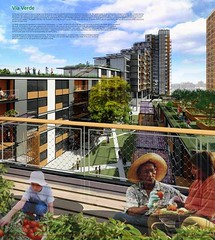 and the truly remarkable Via Verde development stand as wonderful testament to a more hopeful future for low-income families. No doubt there will be lessons to learn from these newer approaches as well, but there is little question that they are improvements upon the old.
and the truly remarkable Via Verde development stand as wonderful testament to a more hopeful future for low-income families. No doubt there will be lessons to learn from these newer approaches as well, but there is little question that they are improvements upon the old.
Unfortunately, these more hopeful innovations are unlikely to provide comfort to families whose dreams were shattered while housed (and largely abandoned) in places like Pruitt-Igoe. Their stories are told in a new documentary, The Pruitt-Igoe Myth, now being screened in theaters across the country. Michael Sagrow commented on the film for The New Yorker:
“The director, Chad Freidrichs, employs evocative archival footage and incisive firsthand reportage to brush away the clichéd and often prejudiced conventional wisdom that puts the blame for the project’s demise on its black residents. He lucidly and tenaciously chronicles how government and business reinforced de-facto segregation and did nothing to stop the collapse of the metropolitan job base, and shows that, once Pruitt-Igoe was up and running, there was little public money available to maintain it.
“Along with this exposé of hopeless botches and compromises, the movie contains surprising recollections of a brief paradise lost. The photographs of the brand-new Pruitt-Igoe buildings (they opened in 1954) sting with an electric poignancy; we learn that the residents viewed them as wondrous havens before they went horribly awry.”
Read more about The Pruitt-Igoe Myth here. This is the trailer:
The Pruitt-Igoe Myth: an Urban History – Film Trailer on Vimeo.
Move your cursor over the images for credit information.
Please also visit NRDC’s sustainable communities video channel.
